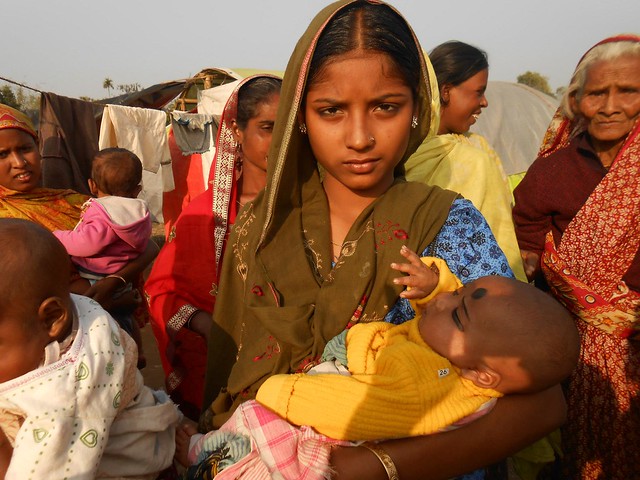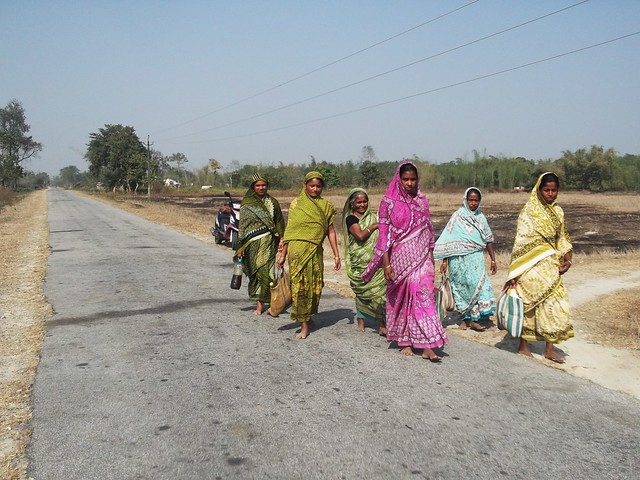By Abdul Kalam Azad for TwoCircles.net,
Assam Legislative Assembly witnessed an unprecedented incident last month on the issues of internally displaced persons of the state. Leader of opposition Sirajuddin Ajmal raised the issue of IDPs during question hour and asked government to give a statement. Other MLAs of AIUDF also tried to persuade the House to issue internally displaced certificate to protect the IDPs from inhuman atrocities in the name of illegal Bangladeshi immigrant. But it created chaos and speaker Pranab Gogoi ‘cashed’ on the situation and suspended the AIUDF MLAs from the remaining business of the house for the day.
This incident again shows the indifferent, insensitive and careless attitude of the ruling parties towards the issues of internally displaced persons of the state. It’s shocking to note that India ranks 11 in the domestic refugee list globally and Assam’s contribution is highest as a state. But till today government doesn’t have any comprehensive policy to deal with the internally displaced persons in the state as well as in the country. After the massive protest and violence in Nandigram and Singur in West Bengal, central government came up with the National Resettlement and Rehabilitation Policy in 2004. But the policy was formulated keeping in mind the development induced internally displaced persons only. The incident of land acquisition and displacement which smashed the thirty-year old Left Front government in West Bengal, but the victims of the displacement are still homeless. On the other hand the said policy remains silent on the issues of natural calamities like flood and erosion induced IDPs.

A mother with her child in a camp in Assam.
United Nations has well formulated guiding principles to deal with the issues of internally displaced persons. The United Nations defines internally displaced persons as “Persons or group of persons who have been forced or obliged to flee or to leave their homes or place of habitual residence in particular as a result of or in order to avoid armed conflict, situation of generalized violence, violation of human rights or natural or human made disasters and who have not crossed an internationally recognized state border”. No doubt the erosion and flood induced IDPs and ethnic violence induced IDPs of Assam come under the ambit of UN’s definition.
While dealing with right to standard of living of IDPs UN’s Guiding Principle 18 outlines “At the minimum, regardless of the circumstances and without discrimination, competent authorities shall provide internally displaced persons with and ensure safe access to: a) Essential food and potable water; b) Basic shelter and housing; c) Appropriate clothing; and d) Essential medical services and sanitation.
But it is observed that the internally displaced persons are most vulnerable and marginalized in the state. They are being excluded from almost all the development initiatives and pro-poor programs of the government. The ethnic violence induced IDPs are facing humanitarian crisis in western Assam. Their livelihood and social setup has been destroyed due to displacement. The aged, children and disabled section of these IDPs are severely affected by the inadequate health and medical interventions. It is being regularly reported that children and elderly persons are dying due to lack of medical facilities in the camps of BTAD area of western Assam. Women are forced to compromise with the dignity and privacy due to lack of sanitary facility and shelter. The UN Guiding Principles advocate that the IDPs should not be discriminated on the ground of race, religion, ethnicity, property etc. But the situation of ethnic violence induced IDPs of western Assam does not correspond to the policy. They are being discriminated on the ground of land record during rehabilitation process!

Woman way to their camp
On the other hand, the situations of natural calamities i.e. flood and erosion induced IDPs are more grave, pathetic and have larger impact on the society as well. It is officially estimated that between 1951 to 2000 river Brahmaputra has eroded 4,29,657 hectors of agricultural land of Assam, which is almost 7 percent of total land of the state. This large scale erosion has displaced nearly three million peasants of the state. This huge displacement has resulted forced migration to other parts of the state for livelihoods and shelter. These downtrodden people are being easily targeted by the anti-social elements in the name of illegal Bangladeshi immigrants. Though UN Guiding Principles says that IDPs has right to liberty of movement and shall be protected from discriminatory arrest; but sometimes they are illegally detained by police also.
The UN Guiding Principles on Internally Displaced also outlines that the IDPs should be protected from any act of violence intended to spread terror among them. But in Assam it is a frequent phenomenon to terrify the IDPs and confine their mobility. Even some in the media also fuel such insane activity, which not only deteriorates the conditions of IDPs, but it also affects the internal labour migration within the state., although internal labour migration is globally acknowledged as a tool to alleviate poverty through cash remittance and to meet MDG (Millennium Development Goal).
In November 2011, IDMC (Internal Displacement Monitoring Centre, Geneva) and NRC (Norwegian Refugee Council) published a report on the IDPs of North East India and Assam. The report provided a numbers of recommendations to government of India and state governments of Northeast. It recommended that government of India should pass legislation in accordance with UN Guiding Principles on Internal Displacement. The report also recommended to union government to provide a watch body like NHRC, NCW, NCM etc to oversee the issues IDPs. At the same time the report has particularly recommended to government of Assam to systematically assess the situation of Adivasis, Bodos, Muslims and other displaced by violence during 1990 to 2000 and determine the number of people still living in displacement and their specific needs. It asked Assam government to provide adequate support to the displaced according to their needs, which should especially include housing and livelihood assistance as well as education and skill training. But nothing has been materialized so far! Rather IDMC issued IDP alert in august 2012 saying that recent violence has induced another 400000 IDPs.

A newborn baby in BTAD camp
The issues of IPDs are not only confined to Assam or India; it is a global issue. And hopefully, many countries are doing commendable job to protect the right of IDPs and rehabilitating them in a systematic manner. Countries like Azarbaijan, Bonsia and Herzegovina, Colombia, Croatia, Georgia etc have enacted law in accordance with UN Guiding Principles. Question arises, why India can’t afford to adopt UN Guiding Principles to deal with the issues of IDPs? Is it out of context to demand a separate law to protect the IDPs from inhuman atrocities and to uphold their human dignity?
(Abdul Kalam is a social work stduent from Guwahati. )
(Photos: Sheela Sharma)
